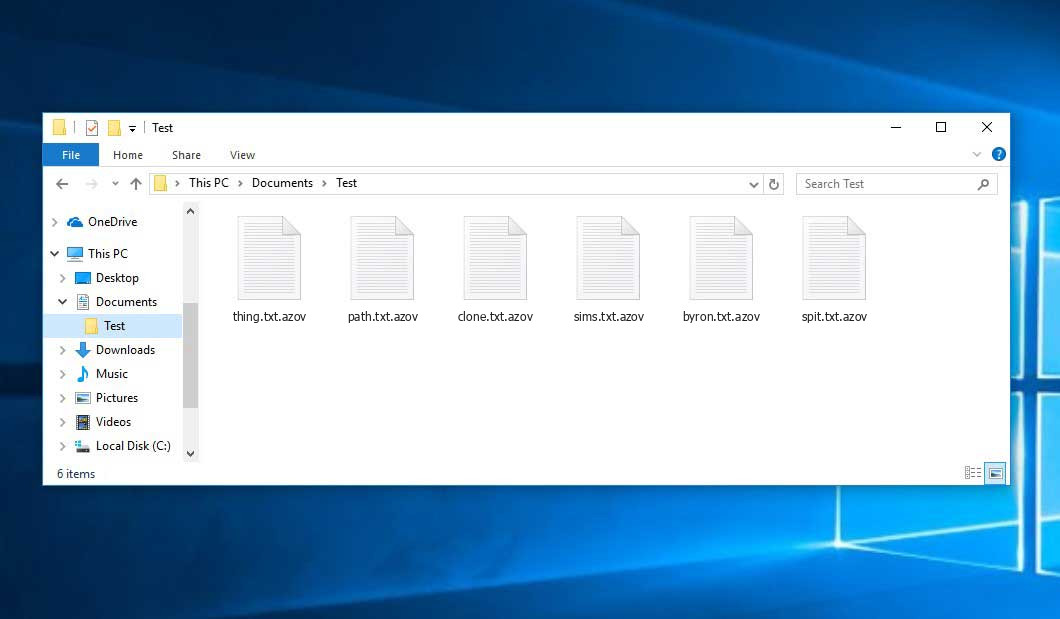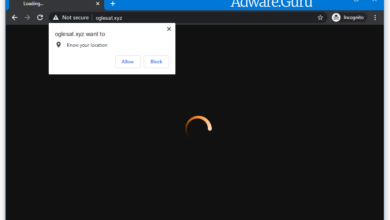Remove Azov Virus (.azov Files Ransomware)
Azov – General Info
The Azov stands for a ransomware-type infection. Azov was elaborated specifically to encrypt all major file types. Once the file is encrypted people are not able to use them. Azov adds the “.azov” extension for each file encrypted by it. For example, the file “myphoto.jpg“, when encrypted by Azov, will be renamed into “myphoto.jpg.azov“. As soon as the encryption is completed, Azov places a special text file into every folder containing the encrypted data.The message given by Azov text file requesting the ransom is definitely the like the statements given by other ransomware representatives. It actually mentions that the info is encrypted which the only way to restore it is to use a a special decryption key. Unfortunately, this is definitely true. The sort of cryptography mechanism used by Azov is still not correctly examined. Still, it is absolutely specific that each victim may be given the specific decryption key, which is completely unique. It is impossible to bring back the files without the key available.
Another technique of Azov is that the victims cannot access to the key. The key is kept on a specific server run by the frauds associated with Azov ransomware. To get the key and recover the important information people have to pay the ransom.
Azov encrypted your documents, but that might not be the only damage done to you. The ransomware might still be hidingon your computer. To identify whether this holds true, we suggest downloading GridinSoft Anti-Malware.
Download GridinSoft Anti-Malware
GridinSoft Anti-Malware Review, How to get free trial?, EULA, and Privacy Policy.
However, irrespective of the requested quantity, people need to keep away from paying the ransom virus. Cyber frauds are not fair, so they tend to entirely ignore what their victims feel about the issue, even when the payment reaches their pockets. This is why paying the ransom normally does not provide any positive outcome and people just lose their money for nothing.
We strongly advise that you do not contact these crooks and definitely do not transfer money into their accounts. It is said to admit that there are no utilities able to crack Azov ransomware and to recover the information data free of charge. Therefore, the only best decision is to recover the lost data from the available backup.
Virus Summary
| Name | Azov Ransomware |
| File Extension | .azov |
| Type | Ransomware |
| Short Description | The ransomware encrypts all the data stored on your system and requires a ransom to be paid on your part supposedly to recover your important files. |
| Symptoms | File encryption by the ransomware is performed by means of the AES and RSA encryption algorithms. Once the encryption is completed, the ransomware adds its special azov extension to all the files modified by it. |
| Distribution Method | Spam Emails, Email Attachments |
| Removal Tool | GridinSoft Anti-Malware |
Keep in mind that the internet is now overwhelmed with threats that look comparable to Azov ransomware. Malicious programs of such kind are generally elaborated to encrypt important data and to set forth the need before the user to pay the ransom. The peculiarity of all such ransomware threats is that all apply a comparable algorithm to create the distinct decryption key for files decryption.
Therefore, as long as the ransomware is still being developed or has some hidden bugs, manually recovering the information is just not feasible. The only method to prevent the loss of your essential information is to routinely create backups of your important information.
Keep in mind that even if you create such backups, they need to be placed into a special storage utility not connect to your main PC. You may use the USB Flash Drive or external hard drive for this purpose, or refer to the help of the cloud storage. If you save your backup files on your common system they may be encrypted together with other files, so it’s certainly not a good storage place.
How did ransomware infect my computer?
There are several methods used by online frauds to distribute Azov ransomware. Despite the fact that it is uncertain how exactly Azov injects your PC, there are some leaks through which it may infiltrate the system:
- integration with third-party software application, especially freeware;
- spam emails from unknown senders;
- sites rendering free hosting services;
- pirated peer-to-peer (P2P) downloads.
Often Azov ransomware might be presented as some legitimate software, for instance, in the pop-ups instructing users to carry out some crucial software updates. This is the typical technique used by online scams to persuade people into downloading and installing Azov infection manually, by methods of their direct participation in the installation process.
Additionally, the criminals might describe different email spam techniques to inject harmful codes into Windows PC. So, they may describe to sending unsolicited spam e-mails with tricky notifications promoting users to download the attachments or click on certain download links, for example, the ones encouraging users to open some photos, documents, tax reports or invoices.
Needless to mention, opening such files or clicking on such dangerous links may severely harm the system. Fictitious Adobe Flash Player update notifies may result in Azov virus injection. When it comes to the cracked applications, these illegally downloaded programs may likewise contain malicious codes causing Azov secret installation. Lastly, injection of Azov may happen by methods of Trojans that privately get injected into the system and install destructive tools without the user’s authorization.
Is there any way to prevent the injection of Azov ransom virus?
Even though there is no 100% guarantee to avoid your computer from getting infected, there are some pieces of advice we wish to share with with you. To start with, be very careful when you browse the web and specifically while downloading free programs. Stay away from opening suspicious email attachments, especially when the sender of the email is not familiar to you.
Keep in mind that some freeware installers may consist of other unwanted utilities in the bundle, so they may be malicious. Make sure that your current antivirus software and your entire operating system is always appropriately updated.
Naturally, downloading pirated software is unlawful and may result in important damage to be made for your PC. For this reason, stay away from downloading cracked software. You are also strongly encouraged to reconsider your existing security software and potentially change to another security solution that can render better services of defending your PC.
Below please find the quotation from the Azov text file:
!Azov ransomware! Hello, my name is hasherezade. I am the polish security expert. To recover your files contact us in twitter: @hasherezade @VK_Intel @demonslay335 @malwrhunterteam @bleepincomputer Слава Україні #Вцебудеукраїна [Why did you do this to my files?] I had to do this to bring your attention to the problem Do not be so ignorant as we were ignoring Crimea seizure for years. The reason the west doesn\'t help enough Ukraine. Their only help is weapons, but no movements towards the peace! Stop the war, go to the streets! Since when that Z-army will be near to my Polska country. The only outcome is nuclear war. Change the future now! Help Ukraine, come to the streets! We want our children to live in the peaceful world. #ВцебудеУкраїна ------------------------------------------------ Biden doesn\'t want help Ukraine. You people of United States, come to the streets, make revolution! Keep America great! ------------------------------------------------ Germany plays against their own people! Du! Ein mann aus Deutschland, kom doch, komm raus! Das ist aber eine Katastrophe, was Biden zu ihnen gemacht hat. Wie war das schoen, wenn Merkel war da? ------------------------------------------------ #TaiwanIsChina
Screenshot of files with “.azov” extension added by the ransomware:

Use GridinSoft Anti-Malware to remove Azov ransomware from your computer
1.Download GridinSoft Anti-Malware.
You can download GridinSoft Anti-Malware by clicking the button below:
2. Double-click on the setup file.
When setup file has finished downloading, double-click on the setup-antimalware-ag.exe file to install GridinSoft Anti-Malware on your computer.

An User Account Control asking you about to allow GridinSoft Anti-Malware to make changes to your device. So, you should click “Yes” to continue with the installation.

3. Press Install button for run GridinSoft Anti-Malware.
3.Once installed, GridinSoft Anti-Malware will automatically run.
4. Wait for the GridinSoft Anti-Malware scan to complete.
GridinSoft Anti-Malware will automatically start scanning your computer for Win Speedup 2018 and other malicious programs. This process can take a 20-30 minutes, so we suggest you periodically check on the status of the scan process.

5. Click on “Clean Now”.
When the scan has completed, you will see the list of infections that GridinSoft Anti-Malware has detected. To remove them click on the “Clean Now” button in right corner.








